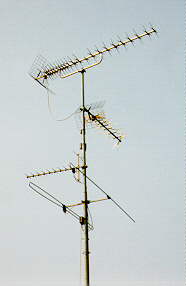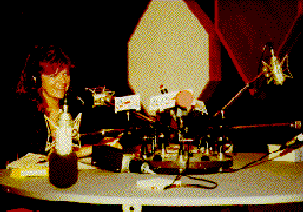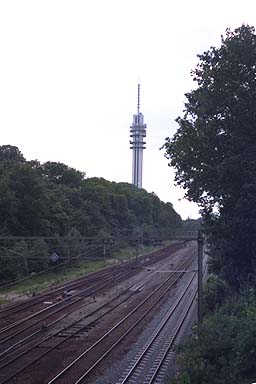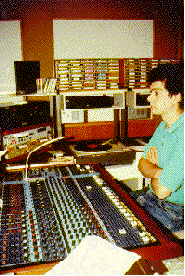
 |
JPL's Wireless Communication Reference WebsiteChapter: Network Concepts and Standards |
 Transmission standards for public and commercial broadcasting exhibit very long life cycles: Successful market introduction of innovations in public broadcast standards requires major investments, including the eventual replacement of receiver sets in all homes. Accordingly, governments and broadcasters hesitate to introduce such new systems.
This results in a significant technology lag for the broadcast services, which current occupy about one half of all radio spectrum below 1 GHz, using outdated standards.
Examples are AM and FM analog radio and
PAL/ SECAM/ NTSC analog TV.
Nonetheless, several upgrades to these standards have been introduced over the years. These enhancements always
ensured that existing receivers in the market could continue to receive the services.
Examples of such enhancements are
Transmission standards for public and commercial broadcasting exhibit very long life cycles: Successful market introduction of innovations in public broadcast standards requires major investments, including the eventual replacement of receiver sets in all homes. Accordingly, governments and broadcasters hesitate to introduce such new systems.
This results in a significant technology lag for the broadcast services, which current occupy about one half of all radio spectrum below 1 GHz, using outdated standards.
Examples are AM and FM analog radio and
PAL/ SECAM/ NTSC analog TV.
Nonetheless, several upgrades to these standards have been introduced over the years. These enhancements always
ensured that existing receivers in the market could continue to receive the services.
Examples of such enhancements are

 An important development is the digitalization
of the networks for radio and television broadcasting. Once deployed, these can
not only disseminate audio and visual material to the public at large but also
provide new (multi-media) services with conditional access. Digital transmission
allows more flexible multiplexing of different traffic streams. Hence, broadcast
networks are not restricted to pure radio and television services, but also allow
encryption for various purposes or watermarking of information for anti-piracy
enforcement and copyright protection. Systems designed for Digital Audio Broadcasting
(DAB) in the European EUREKA program also appear suitable,
in terms of data rates, for transmission of still pictures or data files. Elegant
novel modulation techniques have been
developed that allow significantly more programs to be transmitted within the
same bandwidth. In particular, single-frequency networks, allowing master and
relay transmitters to operate on the same carrier frequencies, will provide a
spectrum efficiency that cannot be achieved with analog FM transmitters. Meanwhile,
for short wave transmission, the system called Digital Radio Mondiale (DRM)
has been developed.
An important development is the digitalization
of the networks for radio and television broadcasting. Once deployed, these can
not only disseminate audio and visual material to the public at large but also
provide new (multi-media) services with conditional access. Digital transmission
allows more flexible multiplexing of different traffic streams. Hence, broadcast
networks are not restricted to pure radio and television services, but also allow
encryption for various purposes or watermarking of information for anti-piracy
enforcement and copyright protection. Systems designed for Digital Audio Broadcasting
(DAB) in the European EUREKA program also appear suitable,
in terms of data rates, for transmission of still pictures or data files. Elegant
novel modulation techniques have been
developed that allow significantly more programs to be transmitted within the
same bandwidth. In particular, single-frequency networks, allowing master and
relay transmitters to operate on the same carrier frequencies, will provide a
spectrum efficiency that cannot be achieved with analog FM transmitters. Meanwhile,
for short wave transmission, the system called Digital Radio Mondiale (DRM)
has been developed.
Most broadcast systems are restricted to one-way transmission, a major drawback for interactive services, but can be augmented by using other networks for the reverse link. Future interactive services to mobile users are often highly asymmetric in their communication requirements. The bulk of data is likely to travel towards the (mobile) users, with only command and control messages traveling in the reverse direction. A broadcast network may support the high data rates required in the downlink. In the context of standardization for future Digital Video Broadcasting (DVB), digital Terrestrial Television broadcasting (DTTB) concepts are also soon to be standardized. Such digital television systems will use MPEG-type video encoding.
 | FM radio, when it was first introduced, delivered a substantial improvement
in audio quality over AM radio. Despite the availability of digital alternatives,
such as DAB, it is still the predominant form of audio broadcasting.
See also: Photo: On Air control room of Radio France Bourgogne, a local FM radio station in Dyon. |

Figure: Dutch teletext page, containing weather forecasts.
Teletext is standardized in CCIR Recommendation 653, Teletext Systems, 1986. It adds a data signal into the blanking interval of an analog television signal. One page contains 24 by 40 characters. It was first in use in the U.K. (1976).